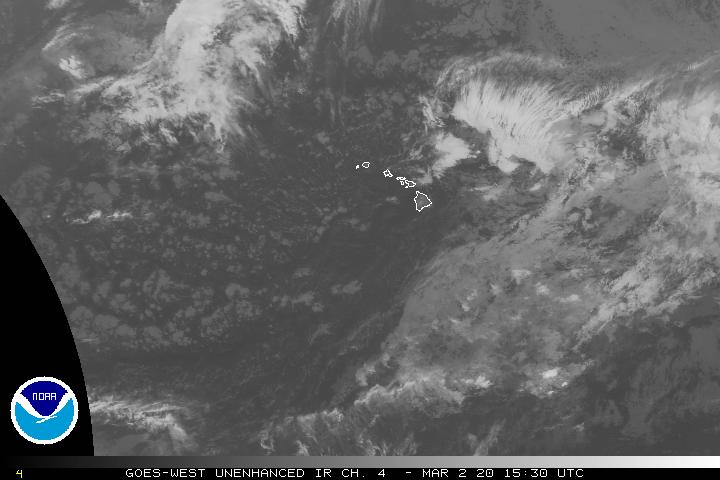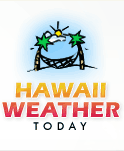Air Temperatures – The following high temperatures (F) were recorded across the state of Hawaii Wednesday…along with the low temperatures Wednesday:
77 – 70 Lihue, Kauai
87 – 74 Honolulu, Oahu
80 – 71 Molokai
83 – 73 Kahului AP, Maui
85 – 75 Kailua Kona
79 – 73 Hilo AP, Hawaii
Here are the latest 24-hour precipitation totals (inches) for each of the islands as of Wednesday evening:
1.32 Mount Waialeale, Kauai
1.03 Poamoho RG 1, Oahu
0.45 Molokai
0.00 Lanai
0.00 Kahoolawe
3.93 West Wailuaiki, Maui
13.57 Saddle Quarry, Big Island
The following numbers represent the strongest wind gusts (mph) as of Wednesday evening:
25 Port Allen, Kauai
32 Kuaokala, Oahu
30 Molokai
25 Lanai
42 Kahoolawe
32 Kahului AP, Maui
27 South Point, Big Island
Hawaii’s Mountains – Here’s a link to the live webcam on the summit of our tallest mountain Mauna Kea (nearly 13,800 feet high) on the Big Island of Hawaii. This webcam is available during the daylight hours here in the islands, and at night whenever there’s a big moon shining down. Also, at night you will be able to see the stars — and the sunrise and sunset too — depending upon weather conditions.
Aloha Paragraphs

High pressure northwest through northeast…cold front north

Deep moisture offshore from the state

Mostly clear to partly cloudy…with cloudy areas

Showers mostly windward and mountains
Looping image
High Surf Advisory…for north shores of Kauai, Oahu, Molokai, Maui / east shores of Kauai, Oahu, Molokai, Maui and the Big Island / west shores of Kauai, Oahu, and Molokai
Small Craft Advisory…strong trade winds and rough seas expected over all coastal and channel waters
Flash Flood Watch…Maui and the Big Island
Flash Flood Warning…windward and interior Kauai
Flood Advisory…windward Big Island
Winter Weather Advisory…Big Island summits
~~~ Hawaii Weather Narrative ~~~
Broad Brush Overview: High pressure north of the state will keep moderate to strong trade winds blowing through the weekend. An upper level trough will remain in the vicinity of the islands through Saturday, before shifting south of the state Sunday. As a result, unsettled and wet trade wind weather will continue through Saturday, with improving weather expected Sunday through early next week. The trade winds will ease early next week as well…as a cold front approaches from the northwest.
Details: High pressure to the northeast of the state will slowly weaken, while the area of high pressure northwest of the islands builds eastward well to the north of the state. This will keep an active trade wind flow in place, with trade wind speeds fluctuating some from day to day. The primary influence on our local weather will be low pressure aloft, which will linger over the islands through Saturday, keeping the airmass somewhat unstable. These unstable conditions, combined with deep tropical moisture…should result in an unsettled and wet trade wind pattern through the work week.
Looking Ahead: Models are now in better agreement for the weekend through early next week outlook. A drier airmass will begin to overspread the island chain Saturday, although there will likely be wetter than normal trade wind shower activity. Sunday and Monday look to improve, with a return of dry trade winds…featuring only light windward showers. The trades will also be on the decrease Sunday through early next week, as a cold front approaches from the northwest. The models bring the cold front southward through the island chain Monday night and Tuesday, which should bring another increase in showers then.
Here’s a wind profile of the Pacific Ocean – Closer view of the islands / Here’s the vog forecast animation / Here’s the latest weather map
Marine environment details: Trade winds are forecast to continue across the island chain. Although winds are expected to decrease marginally, as a cold front passes by far north of the state, they will remain strong enough to sustain small craft advisory (SCA) criteria through the forecast period.
A new north-northwest swell has recently peaked near the advisory level for north facing shores. As a result, a High Surf Advisory (HSA) remains in effect for north facing shores.
A larger north-northwest swell is expected to build, and peak Thursday. This swell will bring advisory level surf to the affected shores, and could bring warning level surf to the north facing shores.
For the east facing shores, trade winds have remained elevated. Thus, wave heights are no longer trending down sufficiently to cancel the HSA for east facing shores. It will remain in effect at least through Thursday afternoon.

World-wide Tropical Cyclone activity
>>> Here’s the latest PDC Weather Wall Presentation, covering Tropical Cyclone 03B, and tropical disturbances being referred to as Invest 96S and Invest 93W
>>> Here’s the latest PDC Weather Wall Presentation…covering the Atlantic Ocean, the Caribbean Sea, and the Gulf of Mexico
![]()
>>> Atlantic Ocean: No active tropical cyclones
>>> Caribbean Sea: No active tropical cyclones
>>> Gulf of Mexico: No active tropical cyclones
Here’s a satellite image of the Caribbean Sea…and the Gulf of Mexico
Here’s the link to the National Hurricane Center (NHC)
>>> Eastern Pacific: No active tropical cyclones
Here’s a wide satellite image that covers the entire area between Mexico, out through the central Pacific…to the International Dateline.
Here’s the link to the National Hurricane Center (NHC)
>>> Central Pacific: No active tropical cyclones
Here’s a link to the Central Pacific Hurricane Center (CPHC)
>>> Northwest Pacific Ocean: No active tropical cyclones
>>> North and South Indian Oceans / Arabian Sea:
Tropical Cyclone 03B is active, here’s a track map, satellite image…and what the computer models are showing
Here’s a link to the Joint Typhoon Warning Center (JTWC)
Interesting: Mount Agung Eruption: The ‘Big One’ Could Come in Hours – A Balinese volcano that has been spewing huge columns of ash in tiny eruptions over the past week could be facing the “big one” very soon, experts now say.
“The potential for a larger eruption is imminent,” Indonesia’s Volcanology and Geological Disaster Mitigation Center, said in a statement.
Gede Suantika, a senior volcanologist with the state’s Volcanology and Geological Disaster Mitigation Center, said the major eruption could be coming within hours, although it’s impossible to say for sure.
Mount Agung, on the Indonesian island of Bali, has been rocked by small eruptions that rained ash clouds. But in the last week, Mount Agung blew steam, a sign volcanologists say means that the magma is heating and instantaneously vaporizing groundwater. Yesterday, a sludgy, cold form of lava known as lahar appeared – a hint that a magmatic eruption was imminent. Late Monday (Nov. 27), a glowing red arc of magma shot across the sky above the towering volcano, reaching nearly two miles in height. The glowing magma show increases the chances that a major magmatic eruption is imminent.
The 10,305-foot-tall volcano began rumbling to life in September. On Sunday, the country’s Volcanology and Geological Disaster Mitigation Center raised Indonesia’s aviation threat level to red, the highest possible level, and the Denpasar International Airport in Bali was closed.
The government has urged more than 100,000 people within a six-mile radius to evacuate.
If Mount Agung does blow, it could send fast-moving clouds of rocky debris and poisonous gas down the mountainsides, known as pyroclastic flows. The last time the mountain erupted, in 1963 and 1964, more than 1,000 people in surrounding villages died.












 Email Glenn James:
Email Glenn James:
David Hume Says:
Hi Glenn, re the comment above. I don’t know where ‘Saddle quarry’ is but it must be close to Mauna Kea summit. I think it could be renamed Saddle lake this week. By your figures they have had 28 inches of rain in the last forty eight hours!!! I have also noted that this year we have had very few record high temperatures. Last year it seemed it was every other day that an old record fell. It goes to show what a huge impact a strong ‘El Nino’ has on our climate. Here on the Kona side today we are back to blue skies and calm seas. Thank you so much for the wealth of information you give us every day. Aloha David Hume.
~~~ Hi David, thanks for your very generous praise for my website!
Here’s where Saddle Quarry is: (https://waterdata.usgs.gov/hi/nwis/nwismap/?site_no=194117155174801&agency_cd=USGS)
Yes, this area has had tons of rain lately, with the trade winds carrying the moisture upslope from the windward side…well upcountry from Hilo!
Sounds like a nice day there on the Kona side…in contrast to the windward showers on your island today. Here in upper Kula on Maui, it’s a great day too.
Aloha, Glenn
Peter Says:
Morning Glen,
Would love to see a 24 hour snow fall total for Mauna Kea. I know it’s not much, but it would be interesting. Aloha.
~~~ Hi Peter, indeed, it would be interesting, however as far as I know there isn’t a source for Mauna Kea snowfall totals. There is a precipitation report for Mauna Loa, although it doesn’t distinguish between rain and snow. This morning’s total there was .32″ as of 5am HST.
Here’s a webcam picture of Mauna Kea (http://www.eao.hawaii.edu/weather/images/ukirt.jpg)…so you may be able to more or less estimate how much snow has fallen.
Good point…
Aloha, Glenn